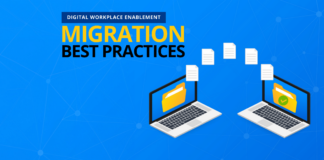Microsoft 365 is indeed a powerful collaboration tool for organizations around the world. But what happens when you have two separate Microsoft 365 tenants?
In today’s podcast, we will dive deep into a project I have been seeing pop up more and more: consolidating tenants and services.
With our guest, Jo Geeraerts, Business Unit Manager – Platform Services at Ordina, we will be looking at how a multi-country organization improved its cross-country efficiency and collaboration possibilities by having one secure, digital workplace platform.
In this episode, we will find out how Ordina built a community where collaboration, employee satisfaction, and productivity are all achieved through a single project.
In this episode:
Ordina’s story
We started the company in 1973. Historically, countries were separated and were functioning as standalones. So when we started IT initiatives in the region, we also did it in a standalone way. This is why we had two active directories and separate Office 365 tenants used in all countries. Essentially, we had been two separate technological entities between Belgium/Luxembourg and the Netherlands.
The problem
Two years ago or even three years ago, our CEO Jo Maes became the head of the entire company. He was very fond of working together. But what you saw back then was people having multiple identities. I was Jo in Belgium, but I was also Jo in the Netherlands. People were experiencing negative impacts on logging in, on identity, finding out which data is where, asking questions like “How can we collaborate better together?” or saying things like, “I didn’t see that kind of information,” “I didn’t notice the news.”
We had two distinct types of tenants –one was open and very free to configure by the end users, and the other one was very closed and restricted. We wanted to work together, but it was not a sustainable situation, obviously. And that’s why we saw the necessity of working together both in the business and the day-to-day work level. That’s where we made sure that we became one and decided to migrate to one tenant.
The start of the project
Before we started the project, we had some sessions with Microsoft to get some ideas on who has migration experience and what are best practices that we can learn before starting. We were moving the entire cloud – 15 TB of content and about 1000 users – from one Office 365 tenant to another.
Initially, we were feeling a little nervous due to the fact that we were the ones being migrated. We help our customers migrate a lot, but this time, we were doing it ourselves. Also, as you know, projects that you do for your own company usually attract the most attention, so you have to do it right the first time and it has to be of very high quality as they’re more critical internally than externally.
Initial challenges
Although the talks of the entire community were positive, there were naturally some people who were against it (as you might expect in a company of 3000 people). But that’s usually where change management comes in. We talked with other unit managers and articulated why we needed to do these things and what’s in it for them.
To prepare for it, we had a community built of champions not only at the start of the project but also during and after managing the project. That way, we understood better and were able to answer questions like:
- “Where are the people coming from?”
- “What are the needs? Are they changed?”
- “Where are we lacking information?”
Change management for this type of project was really important.
The migration process
We started working together with AvePoint on this project end-to-end, and we did some discovery processes on the technical level. The process was good, because if you just migrate point-blank, then you would have had a lot of conflict and a lot of possible issues. So we came up with a clear what-to-migrate list and a clear nomenclature or governance naming conventions. Then we did some pre-migration initiatives by including multiple people from the different business units into our projects. Through AvePoint’s FLY migration schedule, our tenant-to-tenant migration schedule had been smooth and on schedule.
After that, in our new environment, we came up with a unified taxonomy, but we keep that lean. We keep it below a certain amount and then manage it as time goes by, because it grows and changes with your company as well.
On minimizing business disruptions
My biggest concern, because we were doing the migration and we also had several other projects going on, was not having any disruptions. So we worked with a good test environment and pre-production tests. We also selected weekends to conduct the incremental migrations. That way, we were able to minimize the disruption to the end users to zero. We were fairly proud to have this minimal disruption in the end.
The End Result
I remember well that Tuesday morning we went live. I logged on my machine, followed the procedure, and everything went smooth. The first thing I thought of was, “Yeah, this is completed, this is done.” And then you can imagine, instead of seeing 800 people all of a sudden you see 2,800 people, and you see a community, you see a lot of content from one another. Then afterwards, during the project closure meetings, we got some nice feedback from our community and received compliments from our senior leadership team, saying they really liked the result of being able to communicate real fast with their peers in the leadership team of Belgium.
The whole experience of having one environment was actually the start of creating additional value because now we had a common ground that was necessary to start other initiatives. So that was actually a good experience.
The Happiness Factor
To measure the success of the project, we did a survey of both of our communities. We had a number of questions–very open and closed questions–so that based on that, we can calculate the happiness factor. Looking back now, we have seen an increase in happiness, of 7 towards now 7.8–so practically a full point–which is a very good number and we’re happy about it.
Our community was happy since it’s now easier to find information and work together. People coming from the Belgian side were really glad because they transferred into a more open tenant, so now they could do more with the new environment they have. For the first time, we can reach out to the other teams without having to switch from multiple service teams as we now have one service. So that’s all beneficial to the experience.
Today’s takeaway from Jo:
“Planning is key. Have a very good test experience and environment where you can do test scenarios multiple times. Also, having a good migration tool experience is very crucial to limiting downtime. Finally, invest a lot of time in communicating with the management.”
Subscribe where you get your podcasts! Search for “#ShiftHappens” in your favorite podcast app.






